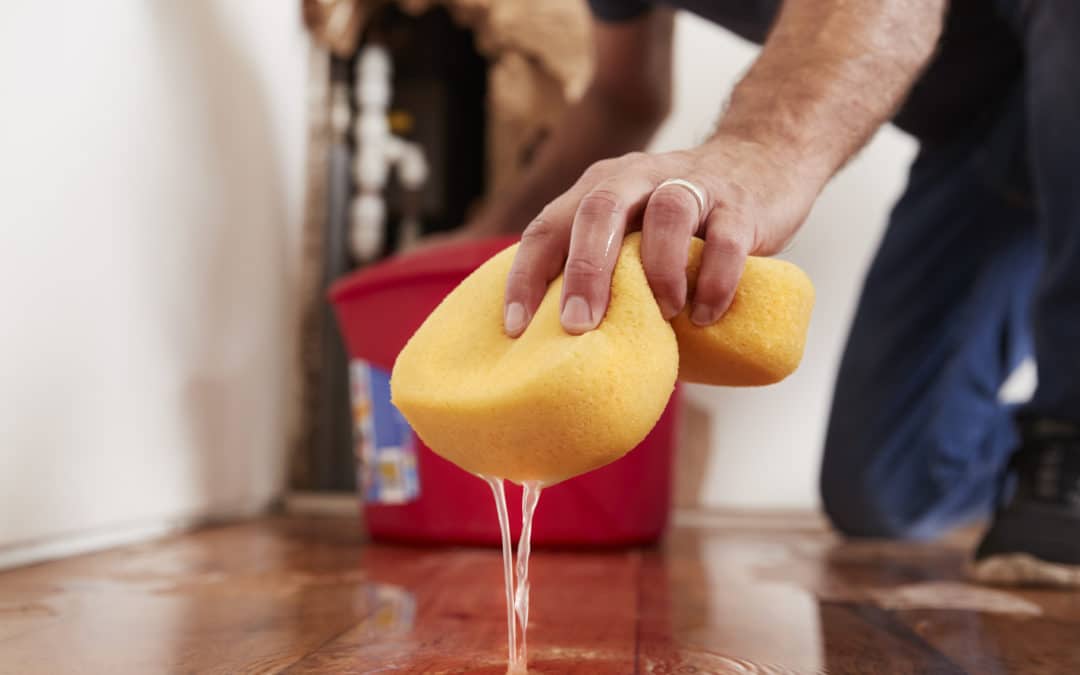
by California Casualty | Homeowners Insurance Info |
Imagine walking downstairs and seeing your basement filled with water and your precious possessions floating around… It’s not something anyone wants to ever experience, but unfortunately, it’s something that many Americans deal with each rainy season.
A flooded basement can cost you thousands (maybe more), and it’s not just in lost belongings. Flooding can cause damage to your walls and floor and also lead to mold, mildew, and other health hazards.
Sometimes flooding is a one-time occurrence. Oftentimes, it is more frequent. Knowing the triggers of flooding can help you take steps to keep your basement dry and your possessions safe. Here are the common causes of a flooded basement. Pro Tip – You can help protect against many of them with flood insurance.
1. Location
Your location is one of the key reasons that your home floods. You may live in a low-lying area prone to flash floods. Your home may sit at the bottom of a hill, drawing precipitation toward it. If the land around your home is sloped down toward it, there could be a risk of your basement flooding. Take a critical look at your property. Look for depressions or standing water around your home, in the ground, or with pavement that has settled or deteriorated. These are areas that you will want to address.
What you can do: Fill the depressions in the ground with a mound of soil to create a slope away from your home. Use clay-based rather than sandy soil, as it will help to repel the water. Remove and/or replace pavement, and again, slope it away from your home. If a hill next to your house is causing the problem, a civil engineer may be able to provide some guidance.
2. Weatherproofing
During construction, your home’s foundation, and your basement’s walls and floor, should have received a coating of sealant to keep water out. However, sealants can deteriorate over time, allowing surface water to leak in. Surface water also can pool around your home due to the location and settings of your lawn irrigation system. Both of these issues are relatively simple to fix.
What you can do: Avoid placing irrigation next to the house, or limit water dispersed there. Make sure your irrigation system does not turn on when there has been plenty of rain. You also can take steps to reseal your basement. Use a polyurethane caulk designed for masonry to seal any cracks or gaps that are larger than 1/8 inch wide. (For finished basements, consult your local hardware store for options.) Then apply a waterproof coating to your basement’s walls and floor. You also can use waterproof paint.
3. Groundwater
If surface water is not the issue, groundwater might be. Underground pressure can push the water into your basement through cracks or holes. If you notice water coming up through the concrete floor, or coming in from multiple points, this could indicate groundwater.
What you can do: A perimeter drain system can help. Such systems relieve the pressure and use gravity to pull the water to the sides and down. They can be installed above or below the slab. An under-floor system may be better but it is more expensive. It requires some of the concrete floor to be removed in order to install the drainage pipes. If you already have a drainage system, such as drain tile or weeping tile, and you are still seeing water or moisture, it’s possible that you need to replace it. Those systems may degrade over time.
4. Clogged Gutters and Downspouts
It’s not unusual for gutters to be clogged with leaves and other debris. This prevents them from effectively doing their job, which is draining the water into a downspout and away from your home. Improperly positioned or broken downspouts also contribute to the problem. Water that drains too close to your house not only can create flooding; it can erode soil which can lead to further problems.
What you can do: Clean your gutters a few times a year. Install a gutter guard to reduce future clogs. Make sure your downspout drains far enough from the wall, at least 5-6 feet. Some experts suggest as much as 10 feet.
5. Plumbing Leaks
If you notice a large amount of water quickly, it could be a plumbing leak. Broken, cracked, and clogged pipes can cause this type of emergency. During winter months, water freezes and expands, sometimes bursting pipes. All of these issues can cause your basement to flood.
What you can do: Most likely, your pipes have to be replaced. Call your plumber to repair the issue as soon as possible.
6. Sump Pump Failure
You may have a sump pump installed, a device that collects excess water and drains it outside your home. A sump pump is powered by electricity, and therefore only works when there is power. Consider buying a sump pump with backup battery power to avoid any interruptions. If your sump pump fails because of lack of power, or because it is not working properly, that could cause your basement to flood.
What you can do: Regular inspection, cleaning, and testing your sump pump can help. Consider an add-on to your homeowner’s insurance of sump pump discharge or overflow coverage. This can help cover the costs of repair and replacement in the event of a sump pump failure.
7. Sewer Backup
Heavy rain can sometimes back up the municipal sewer system. Sewer backups also may occur due to sewer lines that are clogged with waste, tree roots, or other debris. When these things happen, flooding in your basement can occur, and the results will, at minimum, be smelly.
What you can do: If your basement is flooded with sewage, get professional help to clean it. You also will likely need to get the local government involved. Finally, you can install backflow preventers to help keep the sewage out of your house.
If your basement does flood, know that an insurance policy can help cover the costs. Many people don’t realize that a traditional homeowner’s insurance does not cover floods. For that, you will need a separate policy. If you’re in a flood zone, you will want that extra insurance.
There is a 30-day waiting period to buy flood insurance, so with the rainy season upon us don’t wait until the last minute!
This article is furnished by California Casualty, providing auto and home insurance to educators, law enforcement officers, firefighters, and nurses. Get a quote at 1.866.704.8614 or www.calcas.com.
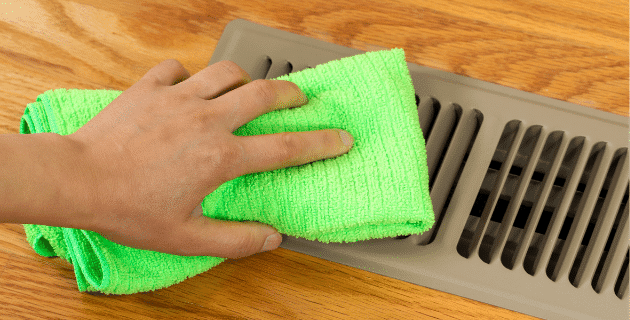
by California Casualty | Homeowners Insurance Info |
There’s a reason spring cleaning is so popular-the birds are chirping, the sun is shining, and there is a sense of newness in the air! There’s no better time to open up those windows and scrub away all signs of winter. However, spring cleaning isn’t just for dusting and decluttering. It’s also a great chance to assess and address safety issues, especially fire hazards.
Every 89 seconds, a fire department responds to a home fire in the U.S. And according to the National Fire Protection Association, in 2020, home fires were responsible for 3,500 deaths, 15,200 injuries, and $21.9 billion in property damage.
When you clean with fire safety in mind, you help protect your home and family from these often-unforeseen fire safety dangers. To help you stay safe this season, we’ve compiled the top safety cleaning tips from fire departments around the country.
Tip #1: Clear your stovetop of fire hazards.
Stovetops account for the majority of kitchen fires. Making sure that there are no flammable hazards nearby will help prevent the flames from catching and spreading a fire.
-
- Keep your stovetop clean between cooking meals.
- Put space between your stove and anything flammable: oven mitts, wooden utensils, towels, wooden stove covers, and kitchen curtains.
- Keep your kitchen counter free of grease or clutter.
- Always stay near the food you are cooking.
- Turn pot handles inward so you can’t accidentally bump them.
Tip #2: Clean the lint trap in your dryer.
Dryers are a common cause of home fires, and too often, the lint traps are the culprit. Making sure your lint trap is not too full will help.
-
- Clean lint filters before or after each load.
- Remove lint from around the dryer rim.
- Make sure the air exhaust vent pipe is free and clear, and that the outdoor vent flap opens when the dryer is on.
- Move flammable items like cardboard and cleaning supplies away from the dryer, especially when it is on.
Tip #3: Check extension cords, outlets, and wiring.
Damaged cords, overtaxed outlets, and old wiring can cause electrical fires. Check these items to make sure that your electrical setup is not putting your safety at risk.
-
- Check for frayed or damaged extension cords. If you find any, throw them out and replace them.
- Make sure your extension cords are rated for the appliances and items that they are powering.
- Do not put electric cords under carpets or across doorways.
- Check to make sure that your outlets aren’t overloaded.
- If an electric appliance smokes, smells funny, or is drawing heat when plugged in, unplug it.
- If you’re familiar with your home’s electrical system and you can take a look, check for scorch marks or frayed wires. Call an electrician to update or rewire the system.
Tip #4: Check for potential fire hazards.
As you do your spring cleaning, check your home for possible fire hazards. Then, take the steps to minimize their risk.
-
- Keep space heaters at least 3 feet from anything that can burn. Turn them off before leaving the room and before going to sleep.
- Practice safety with candle flames. Store matches where children cannot get them. Alternatively use child-resistant lighters.
- If you have a chimney, get it professionally cleaned and inspected. Chimneys can have a build-up accumulation of creosote, a flammable substance that lines the flue.
- Keep cleaning fluids away from heat sources. Many are combustible. These chemicals could even heat up to dangerous levels outside in the sun. (Consider non-toxic cleaners that are safer when heated, such as vinegar mixed with water.)
Tip #5: Remove potential hazards from the garage.
The garage is where we often store our extra stuff. That includes items that could fuel a fire. As part of your cleaning routine, declutter the garage.
-
- Remove stored newspapers, wrapping paper, blankets, and other flammable items that you may be storing in the garage.
- Dispose of oil or greasy rags. Never leave them in a pile. If you must keep them, store them in a labeled metal container.
- Move propane or gasoline outside your home to a shed or detached garage.
- Check your lawn mower’s gas tank for rust. Make sure the fuel line has no leaks. Check any other gas-powered tools, too.
Tip #6: Clear your outside space.
Even fallen leaves and grass clippings can become fuel for a fire. That’s why clearing your yard is so important.
-
- Clean away dead vegetation, fallen branches, and any debris.
- Clean leaves from your roof and gutters.
- Move trash and woodpiles at least 30 feet away from your house.
- Replace mulch, and keep it at least 3 feet from the house.
- Position your barbecue grill away from your home. Also, keep it away from windows, heating and air conditioning units, and vegetation. Clean the grease or fat buildup every time you cook.
- Make sure your propane hose has no leaks or cracks. If you smell gas when you turn it on, shut it off immediately.
Tip #7: Be prepared.
Despite your best efforts, fires can happen. Make sure you are fully prepared to know about them and to take action.
-
- Test smoke alarms monthly. Make sure they have working batteries. Replace batteries every six months. Replace the smoke detectors every 10 years.
- Make sure smoke detectors are on every level of the house, including the basement, and outside every bedroom. Consider interconnected smoke alarms, so if one goes off, then all will sound the alarm.
- Keep fire extinguishers fully charged and easily reachable.
- Make sure doors and windows easily open in case of the need to escape fast.
- Display your house number prominently in case you need to call for help.
- Create a family escape plan. Include a map of each level of your home. Make sure there are 2 escape routes for each room, such as a window and door. Make sure you account for pets, and also name an outside meeting place in the event of an emergency.
- Practice the plan so that everyone is ready, just in case.
For more home tips on fire safety this spring, check out our blog on The 6 Most At-Risk Fire Areas of Your Home.
This article is furnished by California Casualty, providing auto and home insurance to educators, law enforcement officers, firefighters, and nurses. Get a quote at 1.866.704.8614 or www.calcas.com.
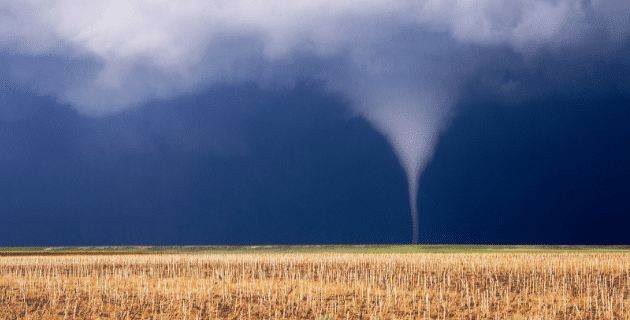
by California Casualty | Auto Insurance Info, Homeowners Insurance Info, Safety |
There’s a reason why a tornado strikes immediate fear for those in its path. These violent storms can flip cars, uproot trees, and destroy entire properties. Their powerful winds can even lift objects hundreds of feet off the ground and leave complete devastation in their wake.
Here’s what you need to know to keep your home, your vehicle, and your family safe from tornadoes and high winds.
What is a tornado?
A tornado is a spinning, funnel-shaped cloud usually formed as part of a thunderstorm. Tornadoes can be over a mile wide and as much as 50 miles long. Their narrow funnel shape extends from sky to ground with winds that can reach speeds up to 300 mph. (To put that in context, the average car can be moved by a 90-mph wind.)
While certain regions of the country have been dubbed “Tornado Alley,” it’s not true that tornadoes are prone to occur in those places. Tornadoes can occur anywhere and anytime and have been reported in all 50 states.
How do we predict tornadoes?
Tornados, and their paths, are notoriously difficult to predict. Even meteorologists who study the weather don’t know for sure how they form. However, the National Weather Service is able to track conditions that can contribute to tornadoes—and issue tornado watches and warnings as needed.
A tornado watch means to prepare for severe weather. A tornado warning means that a funnel cloud has been reported by spotters or indicated by radar.
What are the warning signs of a tornado?
By the time you see warning signs, that means a tornado is well on its way. You’ll need to act fast. Here are just some signs to look for:
-
- Large hail without rain
- Dark or greenish sky
- An approaching cloud of debris
- A loud roar like that of a freight train
- How do you prepare for a tornado?
You can take the steps to protect your home, your car, and your family right now.
1. Sign up for severe weather alerts. You can get critical and timely information from local media broadcasts and the emergency alert system on your TV or desktop and mobile devices. In addition, your local utility company, township, city, or state may offer free alerts. Check with your electric or gas company, and with city hall or municipal government.
2. Develop a family disaster plan. Your plan of action will identify where you and your family will shelter in place, and what to do if you get separated. It also will address any special needs of family members and your pets.
3. If there is not a safe space in your home to wait out a tornado, research local public shelters. For example, if you live in a mobile home, tornadoes can easily turn over mobile homes. Plan to go to a public shelter.
4. Gather emergency supplies in case you need to shelter in place. Keep them together in an easily accessible place. Include water, nonperishable food, and medication. Pack a first aid kit.
5. If there is a tornado watch, store items like outdoor furnishings that could become flying debris. Make sure cars are parked well away from trees.
How do you stay safe during a tornado?
If you’re home…
-
- Go immediately to a safe place such as a basement, storm cellar, center hall, or small interior room in your home. Choose the lowest floor possible and avoid windows. Also, avoid places where heavy items like refrigerators may be directly above you. If a tornado strikes, it could come crashing down.
- For added protection, get under a table. Cover yourself with thick padding such as blankets or even a mattress. This will help in case the ceiling falls in.
- If the power goes out, use flashlights rather than candles if you need a light. An open flame can create a fire hazard if gas lines are damaged by severe weather.
- Have a weather radio or your phone tuned into local weather. Tornadoes can be accompanied by flooding. Know when the tornado is gone and it is safe to emerge.
If you’re driving…
-
- Do not try to outrun a tornado in a car. Pull over.
- Tune into your local weather radio station, or if you are traveling, call the weather emergency number listed on the signs along the highway.
- Park in a low, flat location. Avoid bridges or overpasses.
- If you can, leave your car and get to safety inside a sturdy building.
- If you cannot find adequate shelter, then stay in your car with your seat belt buckled. Put your head down below the windows. Cover your body with a coat or blanket and your head with your arms.
What do you do after a tornado?
Once it is safe to venture out, it’s time to inspect the damage. Wait until daylight and make sure to look around safely. Stay clear of fallen power lines. Stay out of damaged buildings. Make a plan to clear away debris and downed trees from your yard.
If your home, car, or property suffered damage from the tornado, you will want to take the following steps:
-
- Secure your property from further damage.
- Take photos to document what has happened.
- Alert your insurance company, determine if you are covered for the damage, and file a claim.
You have home and car insurance for a reason. Put it to work if you need it. Make sure you and your family are fully protected in the event of a tornado, and any damage that follows, such as flooding. Call a California Casualty agent today at 1.866.704.8614 or visit our website www.calcas.com.
This article is furnished by California Casualty, providing auto and home insurance to educators, law enforcement officers, firefighters, and nurses. Get a quote at 1.866.704.8614 or www.calcas.com.
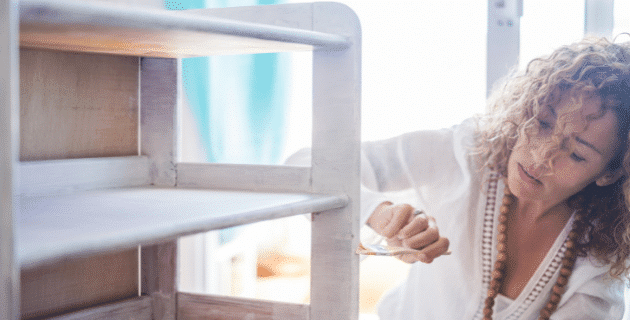
by California Casualty | Homeowners Insurance Info |
Have you spent years dreaming about a home makeover? Or find yourself sitting on social media watching others DIY thinking ‘why can’t I do that?’ You CAN! Believe it or not, you don’t have to be a design expert to create a cozy corner, a relaxing vibe, or a stylish space in your home. Here are some quick and easy DIY room makeovers for your home that you can do this spring to give your space a nice little refreshing update- on a budget.

Bedroom
– Choose a color scheme. Pick two main colors and use them to choose varying textures and patterns which will add visual interest. This will help tie together the look of your room, whether it’s a bedroom or other room in your home. Best colors for bedrooms are cool, relaxing tones. Think shades of blue and muted greens.
– Showcase your headboard. The bed is the focal point in your room. Give it a little drama with the right headboard. For an easy fix, use a curtain behind your bed as the headboard. Make your own fabric headboard with material that matches your color scheme.
– Remember the fifth wall. Who said ceilings need to be white? In bedrooms, we spend our share of the time staring at the ceiling. Paint the ceiling a color, and see how it transforms the space.
– Hang drapes from floor to ceiling. Go a few inches above your window to add height, and have the drapes go down to the floor for an elegant feel.
– Get fancy with hardware: Chances are that your nightstands and dressers have traditional knobs. Change them out for tassel hardware or other fancy options.

Living Room
– Create a gallery wall. Choose the photos that represent wonderful moments in your life, and images of the people who are most important to you. For a cohesive look, choose the same color frames. Make it a statement wall by painting it a color that’s different from the other three walls.
– Include a hobby piece. Do you love to travel? Perhaps you play guitar. See if you can incorporate some of your favorite past times in the décor. A surfboard shelf, framed albums, a world map, or a guitar hung on your wall not only is a decoration, but a reminder of your happy place.
– Wallpaper a wall. Removable wallpaper lets us change our style without the long-term commitment. Choose a vibrant pattern in your color scheme for one focus wall. The wallpaper becomes the art and sets the tone for the space.
– Add wainscoting to your wall. This decorative trim transforms a room with its elegant accent pieces. You can even use the trim as a guide and paint the wall different colors above and below.
– Conceal the clutter. Use baskets or decorative boxes to store magazines, electronics, and loose items that you use regularly. Place them on a bookshelf to keep them out of the way.
– Add an area rug. It doesn’t matter if you have a carpet already in your living room. You can still add an area rug on top. Choose a pattern in your color scheme and it becomes artwork for your floor.
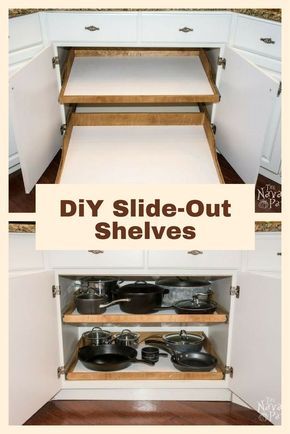
Kitchen
– Add a backsplash. It creates a beautiful focal point behind the stove and in other places above the counters. There are so many options available, from glass mosaics to tile to peel-and-stick. You can find online tutorials on how to install a backsplash from the major retailers and home improvement sites.
– Upscale your knobs and handles. Give your drawers and your cabinets a fresh look by changing out the knobs and handles. It’s a lot easier than painting cabinets, though you can do that, too.
– Install a pot rack on your wall. It’s an easy way to display your cookware while freeing space in your cabinets for other utensils.
– Add under cabinet lighting. You don’t need to be an electrician to install this type of lighting, which is self-adhesive and comes in strips that can be trimmed to fit your space. It plugs into a standard outlet and some models come with dimmer switches.

Bathroom
– Upgrade that mirror. You don’t have to spend a fortune to switch out your plain bathroom mirror for one that will be a focal piece. You can add your own frame. You can also reimagine the space with a find from the local thrift shop. Don’t hesitate to add paint for that special look.
– Paint your bathroom vanity. A little paint can transform an old vanity into a beautiful piece. Switch out the knobs and drawer hardware for an even newer look.
– Change out your towel rack. You can find many towel racks at your local home improvement store. If you have the time, consider making your own to highlight your own personal style.
Not sure where to start?
– Create a mood board. Collect images of items that you like. You can do this on Pinterest or on a PowerPoint or Word document. You can even do it old school and paste the pictures on a board.
– Find your color scheme in a favorite piece of art. See if those colors will work for your room, and of course, make sure that the art piece is part of the décor.
– Move furniture around. Take out a piece of furniture. See what works and what doesn’t for your space.
For more spring DIY décor inspo, check out our Pinterest Board- Staycation DIYs! Be sure to follow us for every new DIY we discover.
Happy decorating! 🙂
This article is furnished by California Casualty, providing auto and home insurance to educators, law enforcement officers, firefighters, and nurses. Get a quote at 1.866.704.8614 or www.calcas.com.

by California Casualty | Homeowners Insurance Info |
Everyone loves a lush, green lawn. But that thick neighbor-envying grass isn’t just pretty to look at or comfortable to walk on; a well-manicured lawn can boost your home’s curb appeal and even its value. Maintaining your lawn regularly will also help keep weeds and harmful pests away.
Keeping up with lawn care is a year-round job (just ask any dad!), but the results are definitely worth it. Follow our lawn care calendar for an easy way to create a healthy and beautiful lawn all year long.
Spring (March, April, May)
– Clean up your yard. Rake up fallen leaves and dead grass. Throw away sticks and other debris.
– Test your soil. You want to know if the nutrient levels and pH are in a good range. You can buy an at-home soil test kit or send it over for a professional analysis to your local cooperative extension, nursery, or university. They will advise on any treatments needed. For example, you can use fast-acting lime to restore pH balance.
– Get your mower ready. Sharpen the blades or have them sharpened. Tune-up the mower. Replace the air filter and spark plug if needed. Fill it with fresh gas.
– Aerate your lawn. Aeration makes holes in your lawn, which open up pathways for air, water, and nutrients to reach the roots of the grass. After you aerate, break up the cores of dirt and leave them on the surface of the grass. They will decompose back into the soil.
– Dethatch. Thatch is a layer of buildup between the soil and grass. A thin layer of thatch helps to insulate the roots and keep moisture in. However, any layer thicker than a half-inch can suffocate your lawn. Check for the thatch level by digging up a patch of grass. Use a dethatching rake to break up the thatch throughout your lawn.
– Fertilize. If you live in cooler climates, fertilize in early spring. Warmer climates can wait until mid to late spring. Use a slow-release fertilizer for the best long-term results.
– Apply herbicides. When the soil reaches 58 degrees Fahrenheit, apply pre-emergent weed control, which keeps weeds like crabgrass from springing up. You can find soil thermometers at garden stores. Consider a pet-friendly herbicide if you have pets using your yard.
– Mow your lawn when the grass starts growing. Cut slightly lower than usual for the first few times. Then, mow as usual, and leave the clippings to decompose. They will help add nutrients to the soil
– Water your lawn so that it gets 1 to 1-1/4 inches of weekly moisture, including rain.
Summer (June, July, August)
– Keep mowed grass tall. Put the mower on the tallest or second-tallest setting. Keeping the blades high will help to shade the soil, reduce water evaporation, and fight against competing weeds.
– Treat grubs. These c-shaped pests are actually the larvae of Japanese beetles. They are nearer the surface during this stage. You can have some grubs, but too many in your grass will damage it. Dig up a square foot section of sod and count the grubs. Less than 10 is fine. If you find more, you will want to apply some type of chemical or organic control. (Not that organic treatment options take longer, and sometimes years.)
– Control weeds. You previously treated with a pre-emergent herbicide. Now try a post-emergent one, when weeds are present. Choose from selective herbicides which will target the weed or nonselective ones which could harm the grass around it. If you choose the second option, read the directions carefully.
– Fertilize to increase energy stores for winter. It may be summer but your grass will be storing nutrients for its dormant season. Plan to fertilize 6-8 weeks before your region’s first expected frost.
– Water your lawn. Use a water calculator to give your lawn the ideal amount for your region.
Fall (September, October, November)
– Keep mowed grass short. By late fall, your mower should be set to about 1.5-2 inches shorter than in the summer. This helps prevent shttps://www.bewaterwise.com/calculator.htmlnow mold and leaves from matting into the grass. Make your final cut of the year slightly lower than normal.
– Test your soil. Make any recommended corrections before winter sets in.
– Fertilize. Feed cool season grass to encourage strong root growth. (To know if your grass is cool season, scroll down to types of grass.)
– Treat with pre-emergent herbicides. Once nighttime temperatures are in the 65-70- degree Fahrenheit range, it’s time to apply herbicides to prevent winter weeds from germinating.
– Reduce watering. Your lawn’s need for water will decrease as rainy season sets in.
– Patch and seed. You may have some bare patches or thin areas. This is the time to seed them. Spread the seed, work it in with a rake, and add a thin layer of straw on top. This will help protect it from the birds and the weather. Water these areas regularly for the first few weeks until the grass is about an inch tall.
– Remove or mulch fallen leaves. You want to improve airflow to the grass roots. This will also help reduce the risk of disease.
Winter (December, January, February)
– Melt ice carefully. Rock salt can damage your lawn but there are ice melts that are designed to be used on grass.
– Consider a midwinter edging. You can keep your lawn neat with an edge and trim as needed.
– If you have trouble areas, take soil samples. Make sure to thaw them out before you test them.
– Fight winter weeds. You can spot green weeds among brown dormant grass. Apply herbicide as needed.
Know Your Grass Type
Did you know grass type varies by region? If you generally experience cold winters, you live in a place with cool season grasses. If you’re in the southern U.S., you live in a place with warm season grasses.
Knowing your grass type will help you decide what to plant and what will grow best on your lawn.
-
- Cool season grasses: Kentucky Bluegrass, Annual Ryegrass, Perennial Ryegrass, Fine Fescue, Tall Fescue, Creeping Bentgrass
- States: Connecticut, Delaware, Idaho, Iowa, Massachusetts, Maryland, Maine, Michigan, Minnesota, Montana, Nebraska, New Hampshire, New Jersey, New York, North Dakota, Oregon, Pennsylvania, Rhode Island, South Dakota, Utah, Vermont, Washington, Wisconsin, Wyoming
- Warm season grasses: Bahia grass, Bermuda grass, Buffalo grass, Carpet grass, Centipede grass, St. Augustine grass, Zoysia grass
- States: Alabama, Arizona, Arkansas, California, Florida, Georgia, Louisiana, Mississippi, New Mexico, South Carolina, Texas
Some grasses like zoysia work in warm and colder climates. Check with your local garden store on recommendations for what grows best in your region.
This article is furnished by California Casualty, providing auto and home insurance to educators, law enforcement officers, firefighters, and nurses. Get a quote at 1.866.704.8614 or www.calcas.com.

by California Casualty | Homeowners Insurance Info |
Getting your house ready to sell can seem like a daunting task. But the good news is, it doesn’t have to be! Knowing what to do, and giving yourself enough time to do it, are the key to keeping it a manageable, and (hopefully) stress-free, experience.
Follow these tried-and-true guidelines to get your home ready to sell.
Tip #1: Clean your home.
It may seem obvious but a dirty home discourages buyers and also can actually influence home appraisers and inspectors. Cleaning your home not only gives the impression that you take care of it, but when you clean, you will also start to notice things that you may want to address before putting your home on the market. For example, you might see a wet spot that indicates a leak or mold. Chances are you’d have to fix that before the sale goes through, so add it to your checklist. Remember, when you clean, make sure that all areas are easily accessible.
Tip #2: Install safety equipment.
Your state may require smoke detectors and carbon monoxide alarms. These are important safety devices that save lives. Understand your local safety requirements and make sure that your home meets them before putting it on the market.
Tip #3: Clean your yard.
As the saying goes, you never have a second chance to make a first impression. The first time that potential buyers will see your home will be from the outside. Therefore, curb appeal is key. Cut the grass, rake the leaves, weed the garden, and trim overgrown shrubs. Take care of obvious problems such as leaves clogging gutters, rotting trim boards, and dead trees. Power wash your house, driveways, and deck. Remove clutter such as toys and bicycles. And if you have the time, plant flowers or greenery.
Tip #4: Make easy home improvements.
Appraisers tend to measure your home’s value in increments of $500. Therefore, if you have obvious damage or you’re missing key items, it could add up against you. Walk around and look with a critical eye. Address the improvements that are easy and affordable: broken doors, nonfunctional locks, faulty light switches, leaky faucets, and other minor issues. If you can, take on the slightly more advanced items such as roof leaks, damaged siding, broken tiles, peeling paint, or anything that looks like neglect. Remember that the kitchen is a key room for buyers. The fastest and easiest way to update this room is with paint and new cabinet hardware.
Tip #5: Get the appraisal done early.
If you’re selling your home, you have to get it appraised. An appraisal* is a professional estimate of your home’s market value. A low appraisal means a lower selling price, so it’s important to present your home for its best value. Schedule it early; this way, if the inspector finds a defect, you can fix it before putting your home on the market.
*Note: An appraisal and a home inspection are not the same thing. A home inspection is a detailed inspection of a home’s plumbing, electric, HVAC systems, roof, and more. It’s almost always the buyer’s responsibility to cover that cost, and it’s done before the sale is closed.
Tip #6: Make a list of upgrades and share documents.
An appraiser won’t automatically know the home improvements you have made, especially since some aren’t easily visible. That’s why it’s helpful to put together a list of improvements. Include dates and warranties if you have them. There are other documents that will be helpful to have ready for your appraiser, including comparable sale numbers in your neighborhood and the home survey that was done when you purchased your home. Your lender or title company may have the property survey on file. If not, try the local tax assessor’s office.
Tip #7: Ask your real estate agent to attend the appraisal.
You’ll want to make it as easy as possible for the appraiser to give your home the value it deserves. Ask your real estate agent to join you at the appraisal and bring comparable sales data to support the sales price. Have him/her talk up the neighborhood and any other selling features: a good school system, a central location. Even having a Trader Joe’s, Starbucks, or Whole Foods nearby can influence home valuation.
Tip #8: Stage your home.
Now the fun begins! Here’s when you or your realtor team can update your home’s décor for a more modern and neutral look. Here are some ideas.
-
-
-
- Repaint walls, hang new curtains, change out lampshades.
- Install shiny new hardware such as doorknobs or faucets.
- Let the light in: clean windows, trim bushes blocking windows, and take down heavy drapes. Increase the wattage in your light bulbs.
- Empty half of the clothes in your closet. Rearrange the remaining clothes so they’re beautifully organized, and box up the rest.
- Take a third of your stuff and put it in storage. Include items like family memorabilia, pictures, etc. You want to depersonalize your home as much as possible.
- Conceal evidence of your pets. If you’re expecting visitors, move their food and water dishes, litter box, and other items away from the main areas. Make sure your home doesn’t smell like pet, too.
- Create a welcoming mood with an entryway that has a small bench, a vase of fresh-cut flowers, or some cookies.
- Keep your home at a comfortable temperature and make sure it’s ready to be shown at a moment’s notice.
For more tips, see our blog on Real Estate Tips for a Hot Market.
This article is furnished by California Casualty, providing auto and home insurance to educators, law enforcement officers, firefighters, and nurses. Get a quote at 1.866.704.8614 or www.calcas.com.










